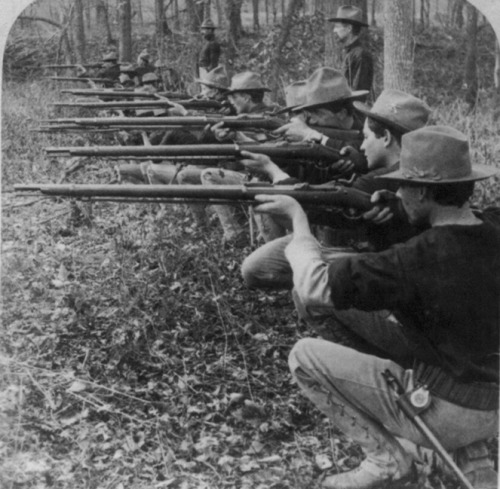peashooter85:Springfield Tradoors of the Spanish American War,Generally it is believed that the Mode
peashooter85:Springfield Tradoors of the Spanish American War,Generally it is believed that the Model 1896 Krag Jorgensen bolt action rifle was the standard issue firearm of the Spanish American War. However, believe it or not many US troops were not lucky enough to be issued the five shot bolt action rifle. Instead many had to make due with the older Springfield Trapdoor single shot breechloader. In a war when the enemy was armed with the bolt action Mauser from Germany, this was a whole new level of suck.First adopted in 1873, the Trapdoor Springfield was the standard service arm of the US Army from 1873 until the 1890’s. Essentially the trapdoor was a conversion of older Springfield muskets from the Civil War, although most were produced on their own. To operate the trapdoor the user had to open the breech and insert a cartridge each time before firing. By the 1890’s this system was woefully outdated as armies began to adopted bolt action repeating rifles which typically held five rounds, sometimes more. I contend that the Trapdoor was outdated from the onset. One example to illustrate the Trapdoor’s inadequacy in firepower was the Battle of Little Bighorn, where men under the command of Custer were overwhelmed and slaughtered by the Sioux, many of whom were armed with Winchester lever action repeating rifles.By 1892 the US Army had adopted the Krag rifle, a bolt action repeater with a five round magazine. While it was the best the United States had to offer, at the beginning of the Spanish American War there were not nearly enough to go around. Regular Army Troops (those who were professional full time soldiers before the war) got first dibs. The hundreds of thousands of volunteers who joined at the start of the war got what was left, first come first serve. As a result, many volunteer units were not issued the best, but instead had to settle with old antiques that were salved from arsenal storage.The most common model issued was the M1889 Trapdoor, which differed little from the original Model 1873, with the exception of a prong bayonet rather than a triangular bayonet. Otherwise it was pretty much the same dang thing. To be issued one would have been an incredible bummer, as you were literally generations behind the weapons used by the enemy. The most obvious drawback to the Trapdoor was its single shot firepower, which was woefully inadequate against modern bolt action rifles. The Trapdoor was also long and heavy, a great liability considering that most of the fighting occurred in areas of heavy vegetation, such as Cuba and the Philippines. In addition the Springfield used a blackpowder cartridge which produced lower velocities compared to smokeless powder, and created a large puff of thick smoke when fired. Soldiers often joked that in battle they could simply hide behind the smokescreen of their rifles. It wasn’t so funny when the combustion of black powder revealed your position. In comparison to the trapdoor, most Spanish soldiers were armed with the Spanish Mauser Model 1893. While holding five rounds in its magazine, it fired 7x57mm smokeless powder cartridge that achieved incredible velocity, range, and accuracy. With the use of stripper clips, the Model 1893 could load and fire dozens of rounds per minute. In contrast an experienced soldier with a trapdoor could only achieve 8-15. The comparison between the two is like World War I biplanes against modern fighter jets.As the war continued production of Krag rifles was ramped up to so that Trapdoors in use could be discontinued and retired. By the invasion of the Philippines and later Philippine Insurrection only secondary units were issued Trapdoors. -- source link

